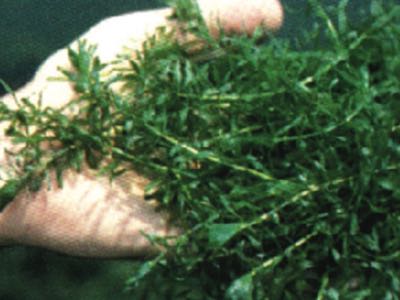Hydrilla
 Hydrilla verticillata was introduced into the U.S. in the 1960s and was first found in the Potomac River in 1982. It is now observed throughout upper Chesapeake Bay.
Hydrilla verticillata was introduced into the U.S. in the 1960s and was first found in the Potomac River in 1982. It is now observed throughout upper Chesapeake Bay.
Description
H. verticillata has slender, heavily branched stems that can reach lengths of 30 feet (10 meters). Leaves are whorled in groups of 3-8, and bear coarse marginal teeth. Midrib of leaf is often red.
Salinity Range
H. verticillata is a freshwater species that reaches greatest abundance in areas with very low or no salinity.
Reproduction & Growth
H. verticillata can reproduce through a variety of mechanisms including sexual reproduction where pollination occurs at the water surface. Asexual reproduction occurs from vegetative growth and fragmentation as well as the production of rootstock, tubers, and turions. Hydrilla is a rapid colonizer, especially in shallow and protected water where it can form dense mats on the surface.
Distribution
H. verticillata is widespread throughout the temperate and tropical regions of the Eastern Hemisphere. It is considered a noxious plant in the U.S. and has been introduced in many European countries. H. verticillata was first introduced into the U.S. in the 1960s and now occurs across the southeastern states to California. It was first found in the Potomac River in 1982 and is now observed throughout upper Chesapeake Bay. It is also abundant in the oligohaline and freshwater areas of the Pamunkey and Mattaponi rivers.
Benefits
Hydrilla is considered an invasive species in the U.S. It crowds out native species, and impedes irrigation and boating.
Threats
There are no known threats to the species.
Visit the IUCN page for range maps, conservation status, and other details.
